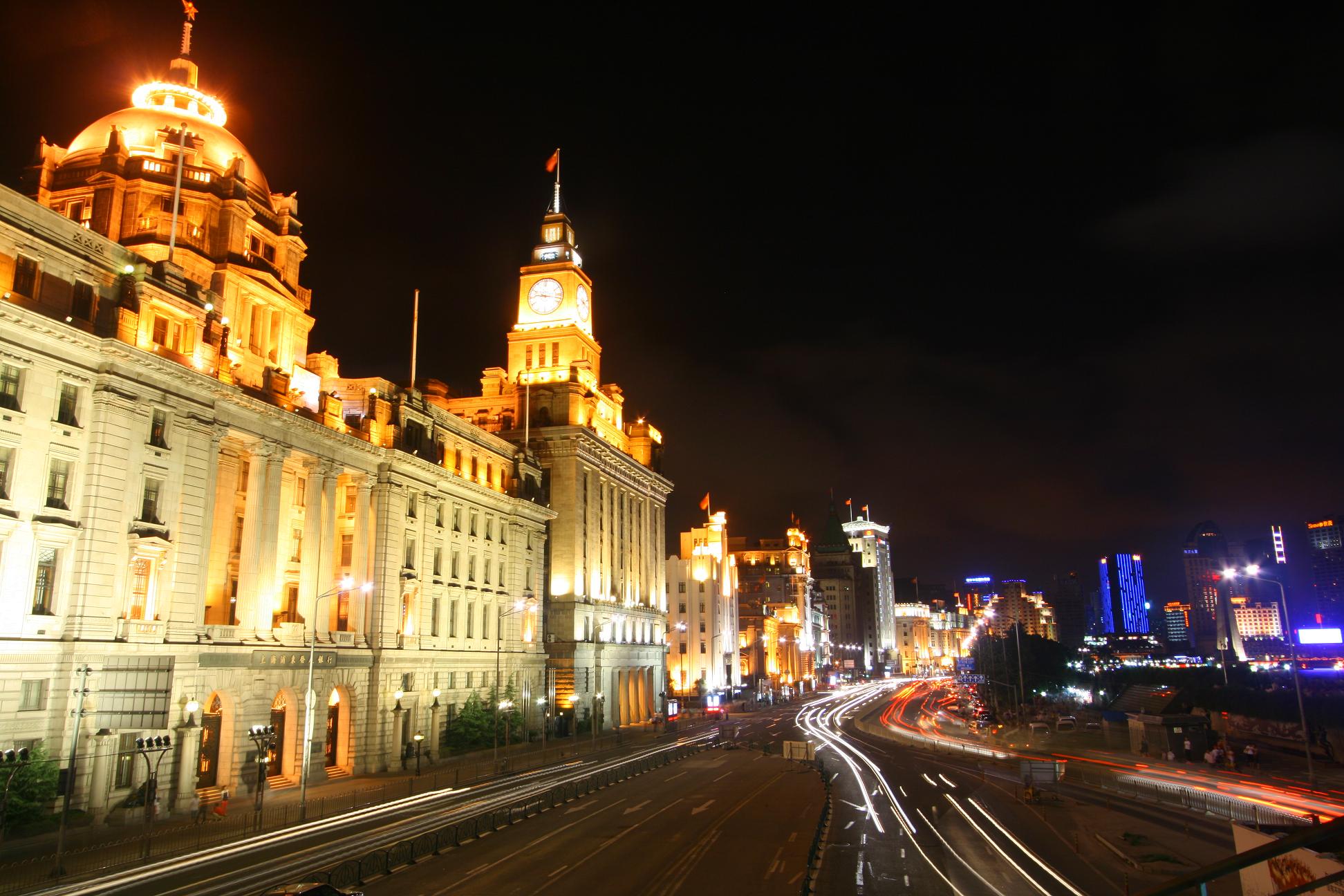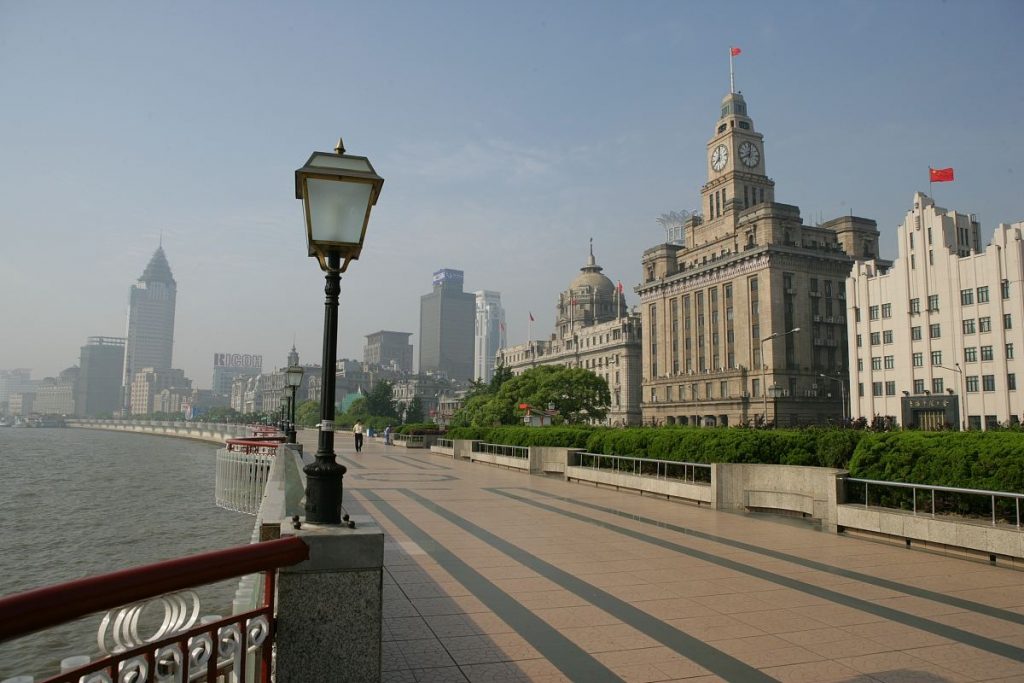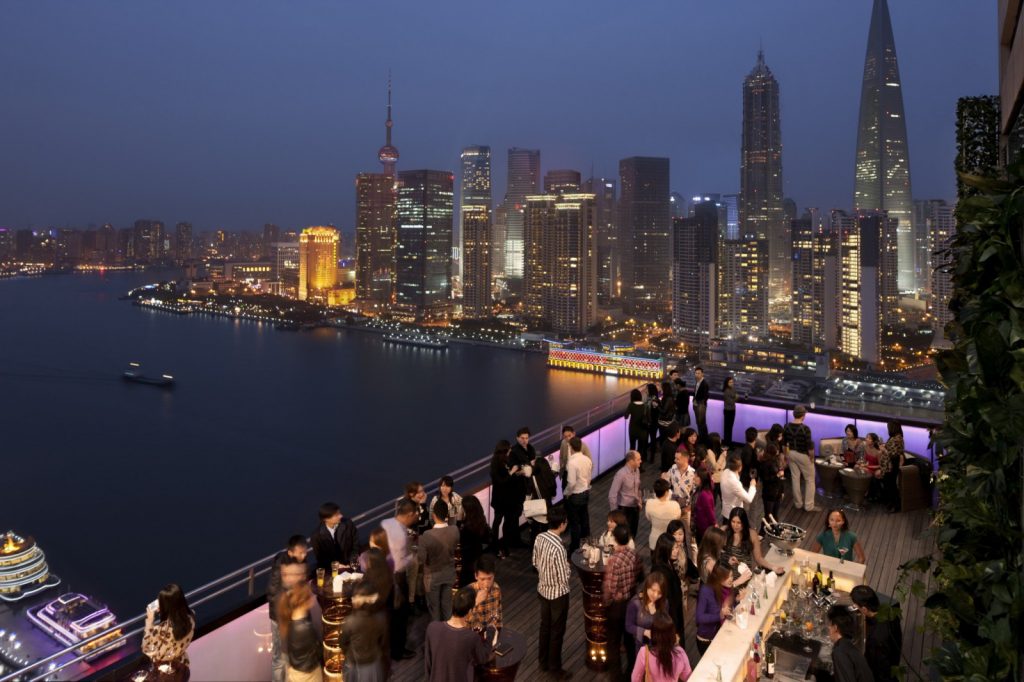
The Bund is an icon of Shanghai and a must-see on a trip to the city. On this page, I will cover a little history, the key architecture and essential travel tips to get the most out of your time there.

The Bund refers to a waterfront area located in the center of Huang Pu District on the bank of the Huangpu River. Originating back in 1844 when the area was designated as the British concession, an area once blocked to the local Chinese under British administration it would later become the starting point of modern Shanghai.
Bund stretches for 1.5 km from just north of Waibaidu Bridge along the western bank of the Huangpu river following Zhongshan Road southwards to Yan’an East Road.
As Shanghai emerged as a commercial port, foreign banks, businesses, associations, newspapers began to gather here and the Bund quickly became the country’s and the Far East’s financial center.
It’s a fascinating place, that not only has an amazing atmosphere containing amazing colonial architecture, but it also tells a story of China’s modern beginning, the end of dynastic rule and early interaction between the east and west.
For some Chinese, they look upon the Bund as an amazing landmark and source of pride, other Chinese will see a humiliating scar left by colonial invaders and turn their view to the skyscrapers of Pudong and admire the rise of modern China that towers over the past.
That aside, it is the number one attraction of Shanghai and a must-visit for locals and foreign visitors to the city. Standing along the Bund are some 52 different styles of historical building.

The Top Historic Buildings
Bund 1: Asia Building
In 1913 by McBain company to invest in the construction of new buildings, completed in 1916. Known as the first ‘mansion’ of the Bund. The appearance of the style is a classical eclectic baroque style and the upper part of the modernist style, the overall symmetrical and stable. Currently the headquarters of China Pacific Insurance Company.
Bund 2: Shanghai Club
Completed in 1910, the Bund area is the first building to use cement, the facade belongs to the British classical style, the integration of part of the Baroque elements, the middle of the six columns highlights the atmosphere, both sides of the top of the Baroque tower. The interior design was conducted by Japan’s Shimoda Taro, and was modeled on the Tokyo Imperial Hotel at the time, so there was ” Oriental London “.
This building also has the oldest of China’s oldest elevator in Asia and Asia’s longest bar, a full 34 meters long! The first Kentucky Fried Chicken in Shanghai was opened here in 1989 and later closed. Now it is home to Waldorf Astoria Hotel on the Bund.
Bund 3: Union Building
The Bund 3 was built in 1916 and was formerly a favored bank in the UK. It was also the tallest steel structure in Shanghai. In 1997, a world-leading architect, Michaell Graves, oversaw restoration and modernisation for it to become a luxury shopping center, Three on Bund.
Bund 5: Nissin Building
Built in 1925 by the Japanese Nisshin Steamship Co., Ltd., due to lack of funds, the introduction of Jewish businessmen’s investment, so the architectural form produced below the modern Japanese Western style, above the classical architecture, also known as ” Japanese-style architecture “. It is now home to a bank and several restaurants.
Bund 6: China Merchants Bank Building
Built in 1897. Originally, China Merchants Bank, founded by Sheng Xuanhuai China’s first commercial bank, designed by the Malaysian business, brick and wood structure, is one of the oldest building on the Bund, belongs to the Gothic revival style.
Bund 7: Danish Great Northern Telegraph Company
Built in 1907, it was originally the Danish Great Northern Telegraph Company ( in 1882 they opened Shanghai’s telephone exchange). The architectural style is a late French Renaissance form. The current use of the Bank of Thailand Bank.
Bund 9: China Shipping Merchant Company
1901 was completed, then by Li Hongzhang to build all the ship China Merchants, has been standing for more than a hundred years, is the Bund big brother. Architectural form is a Renaissance form, the lower stone, the upper layer of water is red brick wall.
Bund 12: HSBC Bank Building
Built in 1923, it was the most expensive construction of the time, spending some 8 million taels of silver. The luxurious building is of neo-classicist design.
Bund 13: Customs House
This building has quite a history, it has been the site of confrontation between British and Qing governments over customs, and the building has been rebuilt several times. The current style is Greek-revival Neo-Classicist design. The clock tower houses Asia’s largest clock, and the bells once played the tune “Westminster Quarters” which was disabled and replaced by speakers playing the tune “the east is red”.
Bund 14: Bank of Communications Building
Built in 1948. It was the last building to be completed on the Bund before the Communists took control of Shanghai in 1949.
Bund 15: China and Russia Road wins Bank Building
Built in 1902 in Italian Renaissance style.It was once home to a Russian bank, then later Chinese bank and now the Shanghai Foreign Exchange Trading Center.
Bund 16: Taiwan Bank Building
Once occupied by the Japanese ran Taiwan Bank it was built in Japanese-style Western style. Now it is home to a branch of China Merchants Bank.
Bund 17: AIA Building
Built in 1924 it was home to The North China Daily News an English-language newspaper. The building combines three styles inc. baroque, neoclassical and renaissance. It is now home to the Shanghai branch of AIA Group Limited.
Bund 18: Chartered Bank Building
Built in 1923. Once home to the Chartered Bank of India, Australia, and China, which as I believe later became Standard Chartered Bank. The building is now home to luxury shopping.
Bund 19: Palace Hotel
Built in 1906. Is currently the South Tower of the Peace Hotel, this building was called the Palace Hotel, is one of the earliest established star hotel in Shanghai.
Bund 20: Peace Hotel
Built on 1929, the Bund was built by real estate tycoon, Victor Sassoon, which was called the “Cathay Hotel”, designed in Chicago-style Gothic style. It is now home to the Fairmont Peace Hotel.
Bund 23: Bank of China Building
Built in 1937. A building funded and built by Chinese, at the time it was a symbolic demonstration of the then emerging Bank of China and it’s ability to compete with international banks.
Bund 24: Yokohama Specie Bank Building
Built in 1924. It was originally owned by the Bank of Tokyo, “Yokohama Gold Bank”, which is known as the gold building, the external door lamp has a beautiful European style. It was once home to the Shanghai Textile Industry Bureau and it is currently home to the Industrial and Commercial Bank of China.
Bund 26: Yangtze Building
Built in 1920 by Yangtze River Water and Fire Insurance Company, incorporating French design. It is currently used by the Agricultural Bank of China.
Bund 27: Jardine Matheson Building
Built in 1922 by Jardine Matheson, a Scottish Company. It is now home to the largest Rolex flagship.
Bund 28: Glen Line Building
Built in 1922. Also known as Yi Tai building, classical style.
Bund 29: Banque de l’Indochine Building
Built in 1914. This building is the last of the old building on the Bund and is the only building financed by the French people, and in full French style.
Bund 33: Consulate-General of the United Kingdom
Once home to the Consulate-General of the United Kingdom, it is now home to the Penninsula Hotel.
Other Main Attractions
Huangpu Park 黄浦公园
Huangpu Park was Shanghai’s first European garden, built in 1886, once a place under British control and blocked to the Chinese people it is now open to all. Today, it’s where you will find the Shanghai People’s Heroes Monument which reflects on the Chinese nation a hundred years of struggle, the Opium War and the May Fourth Movement. In the sunken area there is a large granite relief which stands at 3.8 meters high and 120 meters long. It is a depiction of historical events of the people from 1840 to 1949 and the sacrifices and struggle of the people.
Waibaidu Bridge 外白渡桥
The famous Waibaidu Bridge (Garden Bridge of Shanghai) is one of the landmarks of old Shanghai. In the lower reaches of the Suzhou River estuary, located in the west side of Huangpu Park. The bridge of all-steel structure, features two spans 52.16 meters, 18.3 meters wide.
City Sculpture Group
There are several sculptures and statues along the Bund including those already mentioned and contained within Huangpu Park, outside of those there is Ever Victorious Army Monument that commemorates those who died in battles against the Taiping Army from 1862 to 1864, a statue of Sir Robert Hart, a British-Irishman who served as Inspector General of Chinese Maritime Customs (and many other roles that proved to be of much assistance to the Chinese) and a World War Monument. There is also a copy of the Ney York Stock Exchanges raging bull which has been a point of some controversy.
Chen Yi Square 陈毅广场
A 5.6 meter high bronze statue for modern Shanghai’s first Mayor Chen Yi. The bronze statue sits atop a polished red granite base which alone stands 3.5 meters high.
Valentine’s Wall
Covered in flowers of all colors the wall (actually it’s a flood retaining wall), is a popular attraction for couples to stroll, relax and sit. It’s also a popular place for wedding photos.
Sightseeing Tunnel
The Bund Sightseeing Tunnel is a gateway to Pudong Lujiazui business and tourist areas. Visitors can take the sightseeing carriage and in just a few minutes complete what’s described as a “journey through the earth”, a high-tech dream journey, witnessing the mysterious sky and the vast ocean, and the boiling magma passing through the mantle, the core, all whilst listening and landscape interaction of the majestic sound. Others may call it a light show.
Bund Sightseeing Tunnel is located between Pudong Nanjing East Road Bund and Pudong Lujiazui Oriental Pearl, is China’s first cross-river pedestrian tunnel, a total length of 646.70 meters, completed at the end of 2000.
Suggested Tour route
Bund (Yuanmingyuan Road) – Waibaidu Bridge – Huangpu Park – Bund Historical Memorial Hall and People’s Heroes Monument – Chen Yi Square – Financial Plaza – Yan’an Road Bund Station Square – Jinling East Road Ferry across the river – Pudong Lujiazui.

Best Time to Visit
There is really no bad time to visit, the different times of day will offer different very different experiences.
1. In the morning, catching the early light is a great time for photography, the peacefulness, and also to witness the many people doing traditional activities such as exercise including mass Chinese style of square dancing.
2. For sunset, again, a beautiful time for photography.
3. Night, the Bund alights spectacularly at night, it’s pleasant to stroll along or as many like to do cross the river and get a view from the Pearl Tower or one of the many observation decks in Pudong.
Bars & Restaurants with a View

If you want a relaxing and amazing view of the Bund and even Pudong from a rooftop bar or restaurant, you could visit VUE bar at the Shanghai Hyatt on the Bund, Char Bar at Hotel Indigo Shanghai, Bar Rouge at 18 on the Bund, M on the Bund at #5 on the Bund, The Roosevelt Sky Restaurant and Sky Bar, Jean Georges at Three on the Bund, or TOPS at The Banyan Tree Hotel.
Huangpu River Cruise
A great way to take in the Bund, especially at sunset or at night, is a Huangpu River Cruise which is taken from Shiliupu Wharf near the Bund (531 Zhongshan East 2nd Rd). Boats depart every 15-30 minutes from 11am–9:30pm. The 50-minute classic cruise is perhaps the most popular and costs 120 RMB.
Transport
Metro
Nanjing East Road Station – Metro Line 2 (Pudong International Airport Station → Xu Jing East Station)
Nanjing East Road Station – Metro Line 10 (Jiangwan City Station → Hongqiao Railway Station, Hang Road Station)
Bus routes
20 Road (Jiujiang Road Bund – Zhongshan Park Wanhangdu Road )
26 Road ( New River – Guangyuan Road Hongqiao Road)
33 Road ( in Shandong Road, the new road – military road Pingliang Road)
37 Road ( beautiful garden – Pingliang Road Qiqihar Road)
55 Road (Nanpu Bridge – World Road New Jiangwan City)
65 Road ( Nanpu Bridge – North Bus Station)
71 Road (Shen Kun Road Station – Yan’an East Bund)
123 Road ( People’s Square (Wusheng Road) – Yukai Village)
123 Road section (People’s Square (Wusheng Road) – Yueyang Hospital)
135 Road (old Simon – Yang Shu Pu Road, Li Ping Road)
145 Road (People’s Square (Wusheng Road) – Dunhua Road Songhua River Road)
147 Road (Middle East Road, New Road – Riverside Pier)
576 Road ( Quyang Village – Luheng Road)
868 Road ( Nanpu Bridge – Guoshun East Road Xiang Yin Road)
926 Road (in the East Road, New Road, Shanghai – Shanghai Stadium )
Roads that intersect with the Bund
(The following order south to north and east of Shandong Road intersection)
Yan’an East Road
Guangdong Road
Yuan Fang get
Map of the Bund
Map of the Bund
Fuzhou Road
Hankou Road
Jiujiang Road
Nanjing East Road
Dianchi Road
Beijing East Road
South Suzhou Road